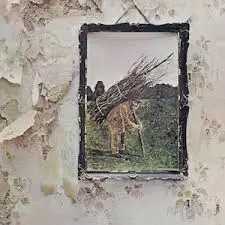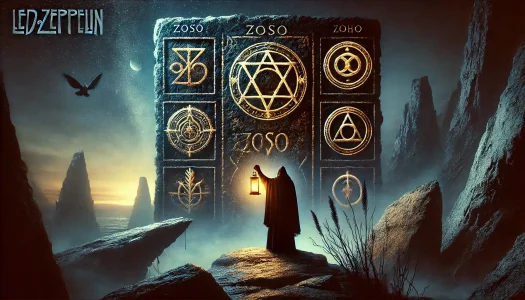Released on November 8, 1971, Led Zeppelin IV stands as one of the most influential and best-selling rock albums of all time. Featuring classics like “Stairway to Heaven,” “Black Dog,” and “When the Levee Breaks,” the album solidified Led Zeppelin’s status as rock legends. Despite its massive success, the band made the unconventional decision to release it without a title or band name on the cover, letting the music—and a set of cryptic symbols—speak for itself.
The album artwork featured four mysterious symbols, each representing a band member, adding to the record’s mystique. Fans and scholars have spent decades analyzing their meaning, with speculation ranging from occult influences to personal philosophies. Alongside these, an additional symbol was included for guest vocalist Sandy Denny, further deepening the album’s enigmatic nature.
Why No Album Title?

By 1971, Led Zeppelin had already achieved massive success, but they were also facing increasing criticism from the press, who often dismissed them as overhyped or derivative. Frustrated with this narrative, Jimmy Page led the decision to release their fourth album with no title, band name, or identifying text—a bold move that forced listeners to focus solely on the music.
The band believed that their work should stand on its own merit, without the influence of marketing or media perception. Page later explained that the choice was a deliberate challenge to critics, making it clear that their artistry didn’t need a label to be recognized. Instead of a title, the album featured four symbols, each chosen by a band member, reinforcing the idea that Zeppelin’s identity was now something greater than just a name.
The Four Core Symbols: What Do They Mean?
Each member of Led Zeppelin selected a personal symbol for the album, adding to its mystique. While some meanings are clear, others—particularly Jimmy Page’s—remain a source of speculation.
Jimmy Page (Zoso) – The Unsolved Mystery
Perhaps the most debated of the four, Jimmy Page’s “Zoso” symbol has never been fully explained. Some believe it originates from a 16th-century alchemical text by Gerolamo Cardano, where a similar glyph represents Saturn, a planet associated with discipline and occult knowledge. Others link it to Aleister Crowley’s esoteric teachings, which Page was known to study. Despite countless theories, Page has never publicly confirmed its meaning, keeping the mystery alive.
John Paul Jones (Trinity Circle) – Balance and Harmony
John Paul Jones chose a triquetra (three interlocking ovals), a symbol found in Celtic and medieval iconography. It represents balance, unity, and interconnectedness, reflecting Jones’ role as the band’s grounding force. This symbol also appears in Rudolf Koch’s Book of Signs, where it denotes a person with confidence and competence—a fitting choice for Zeppelin’s meticulous multi-instrumentalist.
John Bonham (Three Interlocking Circles) – Strength and Family
Bonham’s symbol consists of three overlapping rings, commonly associated with the concept of man, woman, and child—a nod to his strong connection to his family. However, some fans point out its resemblance to the logo of Ballantine Beer, suggesting Bonham, known for his love of drinking, may have had a bit of humor in his choice. Regardless, the symbol reflects his essential role in binding Zeppelin’s powerful sound together.
Robert Plant (Feather in a Circle) – Truth and Enlightenment
Plant’s symbol, a feather enclosed in a circle, comes from Ma’at, the ancient Egyptian goddess of justice, truth, and order. This choice aligns with Plant’s lyrical fascination with mythology and spirituality, as seen in songs like “Stairway to Heaven” and “The Battle of Evermore.” The feather also represents a scribe’s pen, reinforcing Plant’s identity as a storyteller and lyricist.
Sandy Denny’s Symbol
While Led Zeppelin IV is primarily associated with the four core symbols of the band members, there is a fifth, lesser-known symbol—a set of three downward-pointing triangles—which was chosen for Sandy Denny, the only guest vocalist to ever appear on a Led Zeppelin album.
Denny, best known as the lead singer of Fairport Convention, was brought in to duet with Robert Plant on “The Battle of Evermore.” The song, steeped in folklore and mythology, features an ethereal call-and-response between Plant’s warrior-like narrator and Denny’s role as the “town crier,” adding a haunting, medieval quality to the track. Her folk background and storytelling prowess made her the perfect fit for the song’s mystical atmosphere.
To acknowledge her contribution, Denny was assigned her own unique symbol. While the exact meaning remains unclear, the three downward-pointing triangles may symbolize strength, femininity, or a trinity—possibly reflecting the harmonic balance she brought to the song. Though subtle, this inclusion highlights the respect Led Zeppelin had for her artistry and her crucial role in one of the album’s most distinctive tracks.
The Influence of Occult and Mythology
Jimmy Page’s deep fascination with the occult, mysticism, and esoteric symbolism is one of the most enduring aspects of Led Zeppelin’s mythology. A known admirer of Aleister Crowley, the infamous British occultist, Page incorporated arcane imagery into his work, and many believe his influence can be seen throughout Led Zeppelin IV.
Page’s “Zoso” symbol is often linked to Renaissance-era alchemical texts and astrological sigils, both of which Crowley himself studied. The decision to use four cryptic symbols instead of a traditional album title aligns with occult traditions, where symbols hold hidden power and meaning. This secrecy and layered meaning fueled speculation that Led Zeppelin IV was more than just an album—it was a coded statement of the band’s philosophy and interests.
Beyond Page, Robert Plant’s lyrics in songs like “Stairway to Heaven” and “The Battle of Evermore” draw heavily from mythology, medieval lore, and fantasy, reinforcing the album’s mystical aura. Themes of enlightenment, spiritual journeys, and otherworldly realms run through the album, mirroring the symbolic nature of the artwork.
The Mysterious Hermit Artwork
One of the most striking elements of Led Zeppelin IV is the enigmatic artwork featuring a solitary, cloaked figure holding a lantern, perched atop a rugged mountain. This image, which appears on the inner gatefold of the album, is widely believed to represent “The Hermit” from the Tarot deck, a symbol of wisdom, introspection, and spiritual enlightenment.
In Tarot, The Hermit represents a seeker of truth who withdraws from the world to gain deeper knowledge. This imagery aligns with the album’s overarching themes of mysticism, personal journey, and enlightenment, especially evident in songs like “Stairway to Heaven,” where the protagonist embarks on a quest for wisdom. The Hermit’s lantern, glowing with a six-pointed star, symbolizes guidance and illumination, suggesting that knowledge and truth are discovered through solitude and deep introspection.
The artwork was created by Barrington Colby, an artist known for his medieval and mystical illustrations. Jimmy Page, who played a significant role in curating the album’s visual identity, likely saw the Hermit as a representation of self-discovery and transcendence—ideas central to both the music and his own personal philosophy.
